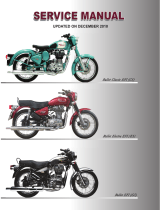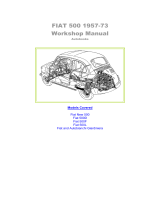Page is loading ...

1
SD-03-812
DESCRIPTION
The Bendix
®
E-2
™
and E-3
™
brake valves are single circuit brake valves
that provide the driver with single point control of the service braking
system. The valve can be either treadle operated or fi tted with a lever
for a linkage connection to a conventional brake pedal. Movement of
the treadle or pedal controls the graduated application and release of
air pressure to the vehicle brake actuators, applying or releasing the
vehicle brakes.
The E-2
™
and E-3
™
brake valves utilize a rubber spring confi ned in a
retainer, resulting in reduced plunger travel as compared to previous
design single circuit brake valves.
The E-3
™
brake valve differs from the E-2
™
valve in that it employs
a different piston (see insert Fig. 1), which requires greater plunger
travel. Because of the greater plunger travel, the E-3
™
valve provides
less sensitivity in the 0-40 psi application range as compared to the
E-2
™
valve. Other than the different pistons, the E-2
™
and E-3
™
valves
are identical. An identifi cation washer, located under the retaining ring
in the valve’s exhaust port, provides a means of identifying the E-2
™
and E-3
™
brake valve.
The E-2
™
and E-3
™
valves have an insert type inlet/exhaust valve
assembly which can be removed without disconnecting air lines. An
exhaust check valve in the bottom of the insert prevents contaminants
from entering the valve through the exhaust port. An optional exhaust
extension is available should an exhaust carry-off line be required.
Porting consists of two (2) 1/2 inch P.T. supply ports, four (4) 3/8 inch
or 1/2 inch P.T. delivery ports, and two (2) 1/4 inch P.T. accessory ports
(in the supply portion of the valve).
OPERATION
Applying
Applying the treadle or pedal exerts a force on the plunger, rubber
graduating spring and piston. The downward movement of the piston
causes the piston stem (which is the exhaust seat) to contact the valve,
closing the exhaust. As the exhaust closes, the inlet valve moves away
from its seat. Air pressure is then allowed to fl ow by the inlet valve, out
the delivery ports and to the brake actuators, applying the brakes.
Bendix
®
E-2
™
& E-3
™
Brake Valves
FIGURE 1 - E-3
™
BRAKE VALVE (SECTIONAL VIEW)
RETAINER
O-RING
PISTON
RETURN
SPRING
RETAINING
RING
PRELOAD
SPRING
EXHAUST CH.
VALVE SEAT
INLET/EXHAUST
VALVE
CAP SCREW
INSERT ASS’Y
SPRING SEAT
WASHER
RUBBER SPRING
RETAINER
VALVE SPRING
O-RING
O-RING
DIAPHRAGM
WASHER
SCREW
11
10
6
2
3
1
4
12
8
9
21
20
19
18
17
16
15
14
13
MOUNTING
PLATE
TREADLE
AUXILIARY
PORTS (2)
DELIVERY
PORTS (4)
EXHAUST
SUPPLY
PORTS (2)
7
PISTON
E-2
™
- E-3
™
BRAKE VALVE
AUXILIARY
PORTS (2)
DELIVERY
PORTS (4)
EXHAUST
SUPPLY
PORTS (2)

2
Balanced
When the air pressure in the cavity beneath the piston and the air
pressure being delivered to the brake actuators equals the mechanical
force on the top of the piston, the piston lifts and the inlet valve closes,
cutting off any further fl ow of air from the supply line through the valve.
The exhaust remains closed, preventing any escape of air through the
exhaust port.
When applications in the above average pressure range are made, the
valve reaches a balanced position as the air pressure beneath the piston
equals the effort exerted by the driver’s foot on the pedal or treadle.
When the piston is pressed down all the way, the inlet valve remains
open and reservoir pressure is delivered to the actuators.
Releasing
When the treadle or pedal application is released, mechanical force is
removed from the top of the piston, air pressure beneath the piston lifts
the piston; (the inlet valve is closed) the exhaust in the valve is open
and the air beneath the piston and in the delivery lines is exhausted
through the exhaust port.
PREVENTIVE MAINTENANCE
Important: Review the warranty policy before performing any
intrusive maintenance procedures. An extended warranty may be voided
if intrusive maintenance is performed during this period.
Because no two vehicles operate under identical conditions,
maintenance and maintenance intervals will vary. Experience is a
valuable guide in determining the best maintenance interval for any
one particular operation.
Visually check for physical damage to the brake valve such as broken
air lines and broken or missing parts.
Every 3 Months, 25,000 Miles or 900 Operating Hours
Lubricate all mechanical actuation (pedal) parts with light (10W) oil.
Apply 2 to 4 drops of oil between the plunger and mounting plate. DO
NOT OVER OIL!!!
Lever/linkage operated valves should be adjusted so that the roller
just contacts plunger. Check for integrity of mounting plate and treadle
and/or pedal.
SERVICE TESTS
Operating Test (IMPORTANT!!! Tests should be
conducted with an accurate test gauge.)
Install gauge in a delivery port or line; depress the treadle or pedal to
several positions between fully released and fully applied positions,
checking the delivery pressure on the gauge to see that it varies
proportionately with the movement of the treadle or pedal. In the fully
applied position, the reading on the gauge should be approximately that
of full reservoir pressure. Upon release of the application, the reading
of the test gauge should fall to zero psi immediately.
Leakage Test
With 100 psi supply pressure and valve in released position, coat exhaust
port with soapsuds arid check for leakage. NO leakage permitted.
Fully apply valve and hold application. Coat exhaust port with soapsuds.
NO leakage permitted. Coat area around top of valve with soapsuds.
NO leakage permitted.
If the valve does not function as described or leakage is excessive, it is
recommended that it be replaced with a new or remanufactured unit, or
repaired with genuine Bendix parts available at our distributors.
REMOVING AND INSTALLING
Removing
Block and hold vehicle by means other than air brakes.
Drain air brake system.
*If only the insert is to be removed, remove retaining ring, and pull
insert out.
If entire valve is to be removed, disconnect air lines from valve.
Remove mounting bolts and remove valve.
Installing
Clean air lines connecting to valve.
Install valve and tighten mounting bolts.
Connect air lines to valve (plug any unused ports).
Test valve as outlined under “Service Tests.”
NOTE: When installing a new or rebuilt insert, pre-check movement of
the inlet and exhaust valve in the exhaust seat by depressing
the insert. Precaution should be taken to prevent damage
to the inlet and exhaust valve and the exhaust check valve
grommet, when installing the insert in the valve. After placing
the insert in the valve body, depress the exhaust check valve
seat and install the retaining ring. Make sure the retaining ring
snaps into the body groove.
DISASSEMBLY
NOTE: Disassembly and assembly instructions are keyed to Fig. 1
sectional view.
1. Remove treadle or lever assembly, boot and plunger.
2. Depress piston assembly and remove retainer (4).
3. Remove piston assembly (7) and piston return spring (2) from
body.
4. Remove o-ring (3) from piston (7).
5. Remove cap screw (6), washer (8), spring seat (9), and
rubber spring (10) from piston assembly (7).
6. Remove retaining ring (1) and inlet/exhaust insert assembly (11)
from body.

3
Insert Disassembly
NOTE: It is recommended that entire inlet/exhaust insert be replaced
as an assembly.
7. Remove o-ring (17) from check valve seat (16).
8. Remove screw (20), washer (19), and diaphragm (18).
9. Depress and hold insert, and remove preload spring (21).
10. Remove inlet/exhaust valve (14), valve spring (13), and o-ring
(15).
11. Remove valve retainer (12).
Cleaning and Inspection
Wash all metal parts in mineral spirits and dry. Wipe all rubber parts
clean.
Inspect all parts for excessive wear or deterioration.
Inspect valve and valve seats for nicks and burrs.
Check springs for cracks, distortion or corrosion.
Inspect exhaust check diaphragm for flexibility, wear, and
deterioration.
Replace all parts not considered serviceable during these
inspections.
ASSEMBLY
1. Lightly lubricate the piston, valve bores, and o-rings with Dow
Corning 55-M pneumatic grease (Bendix piece number 291126).
2. Position rubber spring (10) in piston (7).
3. Install spring seat (9), washer (8), and cap screw (6). Torque cap
screw to 50 inch pounds.
4. Install piston o-ring (3) and place piston return spring (2) in body.
5. Install piston retainer (4). Be certain the prongs snap over groove
in valve body.
Insert Assembly
6. Position preload spring (21) in exhaust check valve seat (16).
7. Install diaphragm (18), diaphragm washer (19) (with lips pointing
out), and install screw (20). Tighten screw securely.
8. Install o-ring (15) and valve retainer (12) on inlet / exhaust valve
body (14).
9. Install valve spring (13) on exhaust check valve seat (16) and install
inlet/exhaust valve (14) into exhaust valve seat (16). Press the
valve down until the preload spring snaps and holds the assembly
together.
10. Install o-ring (17) on exhaust check valve seat (16).
11. Place inlet/exhaust insert in valve body; position identifi cation
washer. Press the insert down while installing retaining ring (1).
Make certain retaining ring snaps into body groove, thus locking
in the insert in place.
Testing A Rebuilt E-2
™
or E-3
™
Brake Valve
Perform operating and leakage tests as outlined in “Service Tests”
section.

4
BW1564 ©2011 Bendix Commercial Vehicle Systems LLC, a member of the Knorr-Bremse Group • All Rights Reserved • 10/11
/

